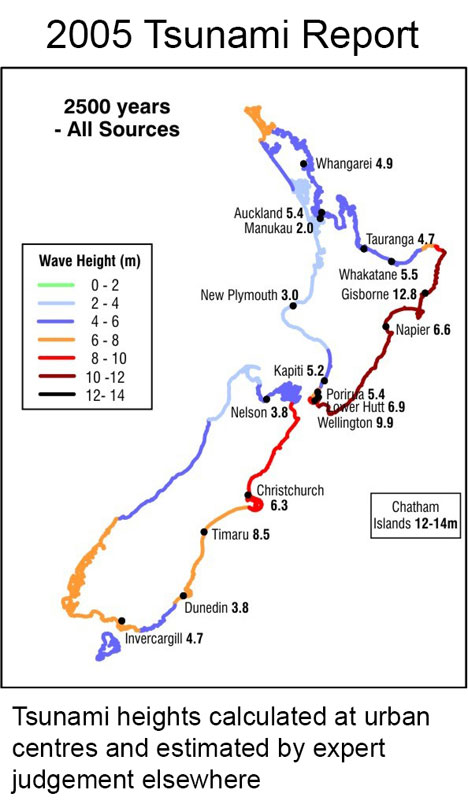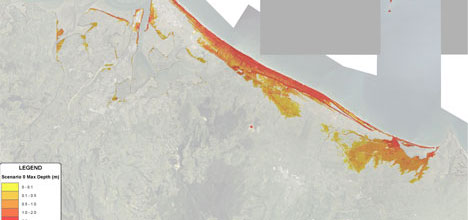Escape routes rather than tsunami sirens are where councils should be spending their money, according to GNS Science latest investigation into New Zealand's tsunami hazards.
The report says New Zealand is in greater danger from larger than expected earthquakes nearby, than it is from tsunami across the Pacific.
Map showing the Papamoa coast at risk of a tsunami.
The Bay of Plenty, Northland, the northwest part of Auckland, Great Barrier Island and the Coromandel Peninsula are areas where tsunami pose a greater hazard than previously understood.
The estimated maximum tsunami wave heights in some of these areas have increased by about 50 per cent. In the Bay of Plenty estimated maximum tsunami heights have gone from 4-6metres to 6-8metres and 8-10 metres. At East Cape the maximum height is now 10-12 metres with 12+m possible on the East Coast.
This is because there is now more uncertainty about the maximum size of earthquakes on plate boundaries. This means that some local and regional tsunamis could be larger than previously estimated, says the report.
For the most hazardous areas – Northland, Great Barrier, parts of East Cape and Wairarapa – it is possible that waves could reach 15m above the normal sea level at the shoreline. In contrast, there are parts of the North Island's west coast where the maximum tsunami height is not expected to exceed 5m.
Report compiler William Power, of GNS Science, says historical evidence shows a dangerous local or regional tsunami occurs in New Zealand every 40 to 50 years, on average.
'So it is likely that at least one such event will occur in the lifetime of most New Zealanders,” says William.
Dr Power said it was impossible for estimates of size and frequency to be exact. But underplaying the danger would be irresponsible, as it could put people at risk.
Key points arising from the report are that the probability of a tsunami has not changed, but the maximum possible size of a tsunami in some areas has increased.
A large tsunami generated very close to New Zealand would arrive before an official warning could be issued.
The report says if people on the coast feel a strong earthquake, or a weak earthquake that lasts more than a minute, then get to high ground or go inland, do not wait for an official warning.
The majority of strongly felt earthquakes will probably not cause a severe tsunami, however the report says the public needs to be educated to evacuate from every strongly felt earthquake as if it were generating the worst case tsunami.

Mass evacuation of cities in the aftermath of a major earthquake is likely to result in many problems, and this will often appear to be unnecessary in hindsight. Yet at present self-evacuation still appears to be the best option in terms of public safety.
As the technology for assessing large local earthquakes improves, and more instruments for tsunami monitoring become available, there will be a problem of public expectations. Without continuing education the public may come to expect to receive a tsunami warning for local events, and may therefore not self-evacuate if no official warning is issued.
'To some extent the installation of tsunami warning sirens, useful for warning of events too far away for the earthquake to be strongly felt, already contributes to this problem.”
The report recommends that seismic modelling should be used to evaluate how a large subduction zone earthquake on the southern Kermadec Trench will be felt at coasts on the opposite side of the offshore Taupo Volcanic Zone, the Coromandel and Northland coasts.
Risk factors for "tsunami earthquakes" should be determined and their presence around the New Zealand coast evaluated.
GNS says the potential for outer-rise earthquakes to generate tsunami close to New Zealand warrants further investigation. Planning and exercises to make mass self-evacuation of vulnerable urban areas as safe and easy as possible in the aftermath of an earthquake should be undertaken.
Education regarding self-evacuation after a strongly felt earthquake, without waiting for an official warning, needs to continue.
The findings come from a 220-page GNS Science report commissioned by the Ministry for Civil Defence and Emergency Management. It updates a 2005 report on New Zealand's tsunami hazards, also produced by GNS Science.
The report incorporates information gathered on the 2004 Indian Ocean, 2009 South Pacific, and 2011 Tohoku tsunamis.
People in the Bay of Plenty must understand and be prepared to respond to the threat of a tsunami, says BOP Civil Defence Emergency Management Group regional manager Clinton Naude.
'This is another tool we will use in our work with BOP agencies and the regional community to ensure the region's tsunami hazards are managed.
'We're analysing the information and identifying questions and areas we want clarified by the Ministry and report authors (GNS) next month when they visit on a roadshow.
'Much of the group's tsunami work has focused on modelled worst case scenarios. The national review takes a probabilistic approach, so it will take some time for us to work through the implications,” says Clinton.
'We want to know if there will be any implications on our latest regional or local scenarios.”
The BOP CDEM Group is pleased to see a key recommendation supports the approach that people need to take action themselves and move to higher/safe ground (self-evacuate) after a strongly felt earthquake - without waiting for an official warning.




6 comments
nice but public say...
Posted on 30-09-2013 19:15 | By Wonkytonk
Good report, problem is the public want a siren as we are not educated. "We want council to spend money on a siren system", sorry waste money, even though the experts say spend it on other things. Come on public listen to those who know, just look at history of these events and see where the sirens failed. It gives you a false sense of security, how many are prepared anyway? not many! but the public demands for sirens becuase they want someone else to take on their responsibility.
rocket science
Posted on 30-09-2013 21:41 | By whatsinaname
don't take rocket science to work that out. big earth quake Kermadecs tonight................
Theodorus
Posted on 30-09-2013 23:53 | By Theodorus
We used to have sirens in Europe during the last war warning us of advancing danger and they worked fine so what are we waiting for!
Sirens
Posted on 01-10-2013 07:34 | By Papamoaner
Very helpful report, but focusses mainly on local earthquakes. We still need sirens for tsunamis from say Solomon Islands, that will give us a good warning. Not everybody has a working cellphone all the time or always with them. Simple common sense sirens could also be used for other emergencies, like tornados that are now on the increase with climate change.
Sirens?
Posted on 01-10-2013 12:26 | By YOGI BEAR
Seems the worst Tsunami's are local and there will be no official warning in time, like before the wave gets here, so the money would be better spent on a road or three out and to higher grounds.
Solomon Island Sirens
Posted on 01-10-2013 15:40 | By YOGI BEAR
No mate, there will be many hours of time from a known Tsunami from there, the real issue is a road to get out of Papamoa, that applies to a close, medium and long range Tsunami.
Leave a Comment
You must be logged in to make a comment.